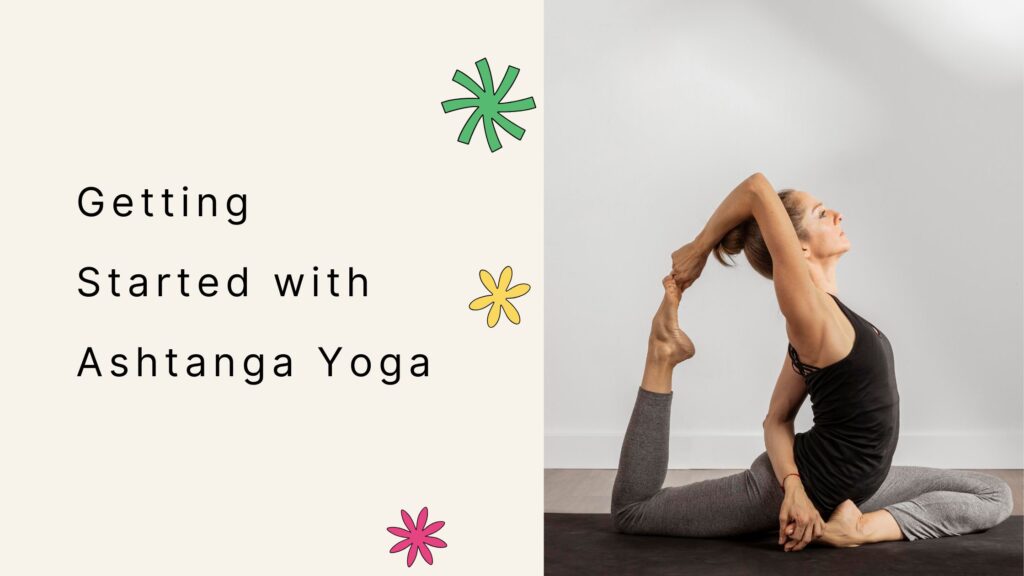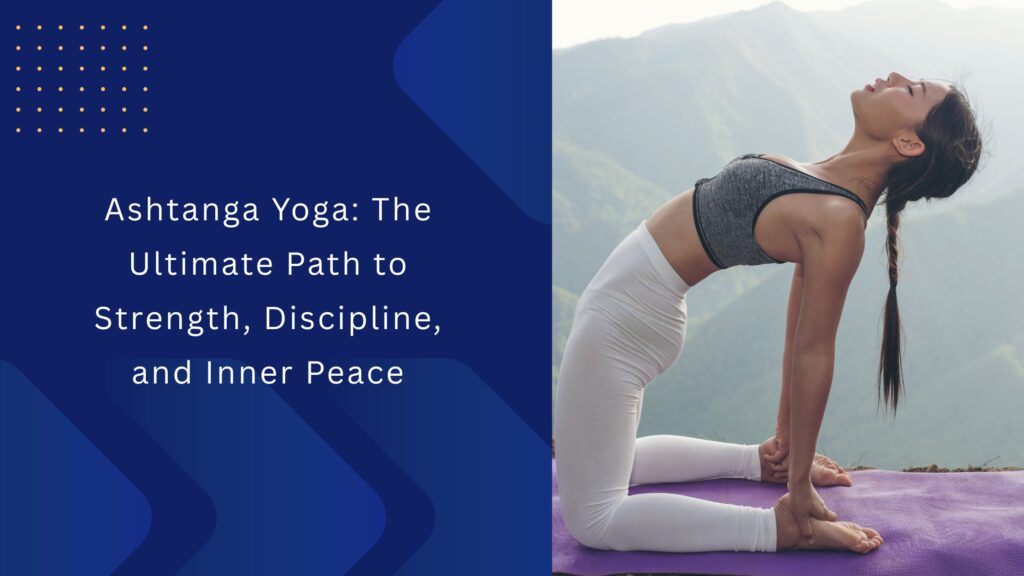Ashtanga Yoga is more than just a workout—it’s a lifestyle, a spiritual discipline, and a powerful system for physical and mental transformation. Rooted in ancient Indian traditions and made famous in the modern world by Pattabhi Jois, Ashtanga Yoga is known for its dynamic flow, structured sequences, and the deep personal growth it fosters.
If you’re looking for a yoga style that builds strength, increases flexibility, improves focus, and connects you to a deeper sense of purpose, Ashtanga Yoga might be exactly what you need.
As with other Ayurvedic relaxation methods, Ashtanga yoga offers a holistic approach aimed at calming the mind and clearing both internal and external blockages. However, rather than relying on stillness like silent meditation, it achieves this through the mental and physical rigor of dynamic practice.
Table of Contents
What Is Ashtanga Yoga?
The word “Ashtanga” means “eight limbs” in Sanskrit, referring to the eightfold path of yoga outlined in the Yoga Sutras of Patanjali. These eight limbs include ethical principles, self-discipline, postures, breath control, sense withdrawal, concentration, meditation, and ultimately, enlightenment.
While most modern yoga classes focus only on postures (asana), Ashtanga Yoga integrates all eight limbs, encouraging a complete and holistic approach to health and spiritual development.
Developed by Sri K. Pattabhi Jois in the 20th century, Ashtanga Yoga follows a precise sequence of poses, practiced in a flowing, breath-synchronized style known as Vinyasa. It’s a rigorous, transformative practice that challenges both the body and the mind.
The Structure of Ashtanga Yoga Practice
One of the defining characteristics of Ashtanga Yoga is its structured sequence system. Unlike other yoga styles that may vary class to class, Ashtanga follows a consistent pattern designed to deepen the practice over time.
The Six Series of Ashtanga Yoga
- Primary Series (Yoga Chikitsa) – Detoxifies and aligns the body.
- Intermediate Series (Nadi Shodhana) – Cleanses the nervous system.
- Advanced Series A-D (Sthira Bhaga) – Strength, grace, and stamina.
Most practitioners work with the Primary Series for years, mastering poses, improving breath control, and gradually moving forward under the guidance of a teacher.
Breath, Bandhas, and Drishti
Ashtanga Yoga isn’t just about doing poses—it’s about doing them with intention and focus. Each movement is linked to breath (Ujjayi Pranayama), supported by internal locks (Bandhas), and directed by gaze points (Drishti).
This trio—breath, bandha, and drishti—creates a moving meditation, bringing mental clarity and presence into every moment of the practice.
Top Benefits of Practicing Ashtanga Yoga
If you’re considering making Ashtanga Yoga part of your routine, you’re in for a wealth of benefits—physical, mental, and spiritual.
1. Builds Strength and Flexibility
Ashtanga Yoga is known for its intensity. It requires and builds core strength, stamina, and flexibility through a series of flowing poses. Over time, your body becomes stronger, more agile, and better balanced.
2. Enhances Focus and Discipline
The set sequence of Ashtanga Yoga instills a strong sense of discipline. As you return to the same postures daily, you train your mind to stay focused, committed, and patient—a skill that spills over into everyday life.
3. Detoxifies the Body
The continuous movement and synchronized breathing generate internal heat, causing the body to sweat and release toxins. This process not only detoxifies the body but also cleanses the mind.
4. Reduces Stress and Anxiety
Like other forms of yoga, Ashtanga incorporates breath control and mindfulness, which help reduce cortisol levels and lower anxiety. However, Ashtanga’s structured nature gives you a clear path and routine, making it especially grounding in times of stress.
5. Deepens Spiritual Connection
By incorporating ethical practices, breath control, and meditation, Ashtanga Yoga supports spiritual development. Whether or not you’re religious, this style helps you connect with your deeper self.
| Category | Details |
| Meaning | “Ashtanga” means “eight limbs” in Sanskrit, referring to the eightfold path of yoga from the Yoga Sutras of Patanjali. |
| Origin | Developed by Sri K. Pattabhi Jois; rooted in ancient yogic traditions of India. |
| Practice Structure | Fixed sequence of postures, performed in a flowing style (Vinyasa) with synchronized breath, internal locks (bandhas), and gaze (drishti). |
| Series | – Primary Series (Yoga Chikitsa) – Intermediate Series (Nadi Shodhana) – Advanced Series A–D (Sthira Bhaga) |
| Key Components | – Ujjayi Pranayama (breath) – Bandhas (energy locks) – Drishti (gaze focus) |
| Top Benefits | – Builds strength and flexibility – Detoxifies body – Increases focus and discipline – Reduces stress – Deepens self-awareness |
| Comparison to Other Styles | More structured than Vinyasa, more intense than Hatha, and more traditional than Power Yoga. |
| Who Can Practice? | Suitable for all levels with modifications; best for those who value discipline, structure, and inner growth. |
| Getting Started Tips | – Begin with Mysore-style classes – Learn from a qualified teacher – Start a home practice slowly and consistently |
| Challenges | Physical intensity, mental resistance, slow visible progress. Overcome through consistency and mindfulness. |
| Lifestyle & Philosophy | Based on ethical guidelines (Yamas & Niyamas), clean diet, daily discipline, and spiritual growth. |
| Practice Frequency | Traditionally 6 days/week; beginners can start with 2–3 times/week. |
| Mysore Style Explained | Self-paced practice in a class setting with one-on-one teacher assistance—ideal for personalized learning. |
Ashtanga Yoga vs Other Yoga Styles
Wondering how Ashtanga Yoga compares to other popular yoga styles? Let’s break it down.
Ashtanga Yoga vs Vinyasa Yoga
Both use flow and breath, but Ashtanga Yoga has fixed sequences, while Vinyasa classes often change daily. Ashtanga is more disciplined and demanding, appealing to those who thrive on routine.
Ashtanga Yoga vs Hatha Yoga
Hatha Yoga is slower and more gentle, focusing on alignment and posture. Ashtanga is more athletic, offering a rigorous physical challenge that also builds mental toughness.
Ashtanga Yoga vs Power Yoga
Power Yoga is often inspired by Ashtanga, but it lacks the traditional sequencing and spiritual depth. If you’re looking for authenticity and holistic growth, Ashtanga Yoga is the clear winner.
Who Should Practice Ashtanga Yoga?
Many people think Ashtanga Yoga is only for the young, flexible, or athletic. That’s a myth.
While it’s certainly intense, Ashtanga Yoga is for anyone with dedication and patience. It can be modified for beginners, and poses can be adapted to accommodate injuries or limitations.
What matters most is consistency, not perfection.
If you’re someone who appreciates structure, enjoys setting goals, and values inner growth, Ashtanga Yoga will fit you beautifully.
Read more: Yoga Nidra: The Ultimate Guide to Deep Rest and Inner Awakening
Read more: Hatha Yoga: The Ancient Path to Modern Wellness

Getting Started with Ashtanga Yoga
Ready to give Ashtanga Yoga a try? Here’s how to get started with confidence.
Try a Mysore Class
Unlike typical led classes, Mysore-style classes allow you to move at your own pace under the guidance of a teacher. This is the traditional way Ashtanga Yoga is taught and is ideal for building a long-term personal practice.
Find a Qualified Teacher
Look for certified instructors who have studied the system deeply—preferably with direct experience in Mysore, India. A skilled teacher ensures proper alignment, safety, and growth.
Create a Home Practice
Once you learn the sequence, you can practice at home. Start with the Sun Salutations and gradually add poses. Even 15–30 minutes a day can create noticeable change.
Be Patient
Progress in Ashtanga Yoga takes time. Don’t rush. Trust the process, and know that each practice is a step toward mastery—both on and off the mat.
Overcoming Challenges in Ashtanga Yoga
As with any demanding practice, you’ll face hurdles—but each challenge is an opportunity to grow.
Physical Struggles
You may experience soreness, fatigue, or stiffness. This is normal. Practice with awareness and modify poses as needed. Listen to your body.
Mental Resistance
Some days, you won’t feel like stepping on the mat. That’s when discipline matters most. Ashtanga Yoga teaches you to show up regardless of mood, and that lesson is priceless.
Plateaus in Progress
You might feel stuck doing the same poses day after day. Remember, repetition builds depth. Trust that change is happening, even when it’s not obvious.
The Deeper Philosophy of Ashtanga Yoga
At its core, Ashtanga Yoga isn’t just physical—it’s deeply philosophical. It encourages practitioners to live by the Yamas (ethical restraints) and Niyamas (personal observances), such as:
- Ahimsa (non-violence)
- Satya (truthfulness)
- Saucha (cleanliness)
- Tapas (discipline)
By living these principles, your yoga extends beyond the mat and into your daily life, relationships, and choices.
Many Ashtanga practitioners also follow a vegetarian or sattvic diet, maintain regular routines, and engage in self-reflection—creating a life aligned with yogic values.
Is Ashtanga Yoga Right for You?
If you’re looking for a yoga style that:
- Offers structure and discipline
- Challenges you physically and mentally
- Promotes spiritual and personal growth
- Builds consistency and commitment
Then Ashtanga Yoga is absolutely worth exploring.
It may not be easy, but the results—clarity, strength, calm, and a deeper connection with yourself—are well worth the effort.
Conclusion: Start Your Ashtanga Yoga Journey Today
Ashtanga Yoga isn’t just another fitness trend. It’s a timeless, tested path to vitality, clarity, and inner transformation. If you’re ready to take your yoga practice to the next level—both physically and spiritually—Ashtanga Yoga offers the perfect foundation.
Whether you’re a curious beginner or an experienced yogi, the discipline and beauty of Ashtanga will challenge you, uplift you, and awaken parts of you you never knew existed.
Roll out your mat, take a deep breath, and begin your journey today.
Frequently Asked Questions About Ashtanga Yoga
Q. Is Ashtanga Yoga good for beginners?
Ans: Yes, with proper guidance. Beginners can start with modified poses and gradually build up to the full sequence.
Q. How often should I practice Ashtanga Yoga?
Ans: Traditionally, it’s practiced six days a week, but even 2–3 times a week can yield great benefits.
Q. Can I practice Ashtanga Yoga at home?
Ans: Absolutely. Once you’ve learned the sequence, a home practice can be very powerful.
Q. What is Mysore-style Ashtanga?
Ans: A self-paced class where students practice the sequence independently, with one-on-one teacher guidance. It’s the most traditional and personalized way to learn.
Q. What is Ashtanga Yoga and how is it different from other styles?
Ans: Ashtanga Yoga is a dynamic, structured style of yoga that follows a fixed sequence of poses, focusing on breath, internal locks, and gaze. Unlike other styles, it emphasizes discipline, consistency, and spiritual growth through a set routine.
Q. Is Ashtanga the hardest yoga?
Ans: Hatha yoga is generally more accessible, while Ashtanga and Vinyasa flow are more demanding and comprehensive practices.
Q. What is the ultimate goal of Ashtanga yoga?
Ans: The ultimate aim of Ashtanga Yoga, based on its philosophical roots, is to reach Samadhi- a state of blissful awareness, spiritual liberation, and enlightenment. This is accomplished by following the eightfold path of Ashtanga Yoga, which culminates in the realization of one’s true self and the unification of individual and universal consciousness.
Q. What is unique about Ashtanga Yoga?
Ans: This yoga style follows a specific, unchanging sequence of poses—known as a series—that you repeat with each practice. It’s often described as a moving meditation, where each movement is synchronized with the breath to help focus and calm the mind. Ashtanga Yoga consists of six distinct series in total.
Q. How many asanas are in Ashtanga?
Ans: More than a thousand years later, the Hatha Yoga Pradipika references 84 asanas attributed to Shiva, highlighting four as especially significant—Siddhasana (accomplished pose), Padmasana (lotus pose), Simhasana (lion pose), and Bhadrasana (glorious pose)—and provides instructions for these four along with eleven additional postures.
We use third-party videos and images on https://yogavidhi.com/ for educational and illustrative purposes. All rights belong to their respective owners. No copyright infringement is intended.



